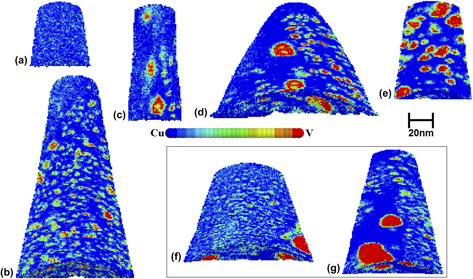Article contents
Novel nanoscale precipitate structures in ion-irradiated Cu1−xVx alloys: “Cherry-pit” formation
Published online by Cambridge University Press: 18 December 2014
Abstract

The nanoscale precipitation induced by 1.8 MeV ion irradiation in Cu1−xVx thin films, with x ≈ 0.09 and 0.91, was studied by atom probe tomography. For the Cu91V9 alloys, irradiation in the range of 300–500 °C led to steady-state compositional patterning of V-rich nanoprecipitates. V nanoprecipitates larger than ∼10 nm in diameter, moreover, contained Cu-rich cores, resulting in an unusual “cherry-pit” nanostructure. The number of these pits within one precipitate increased with the precipitate size, but with the volume fraction of pits within a given precipitate remaining roughly constant, from ∼1.5 to 5%. Similar irradiations performed on V91Cu9 also resulted in an enhanced precipitation reaction, but with smaller Cu-rich nanoprecipitates, <3 nm in diameter, and no “cherry pits.” These results are rationalized using recent atomistic simulations that have explored the conditions for stabilizing by ion irradiation “cherry-pit” nanostructures in immiscible A–B alloy systems, such as Cu–V.
Keywords
- Type
- Articles
- Information
- Copyright
- Copyright © Materials Research Society 2015
References
REFERENCES
- 5
- Cited by


